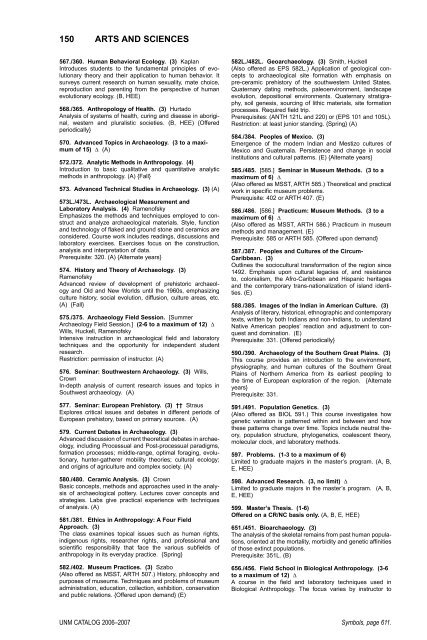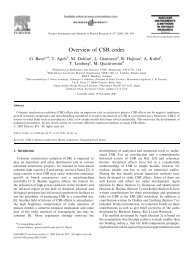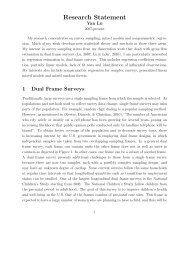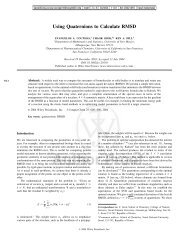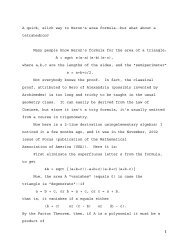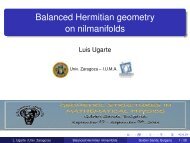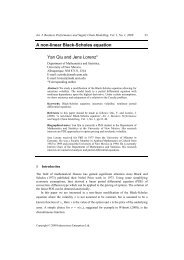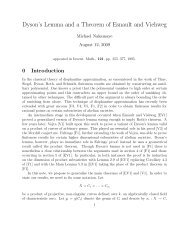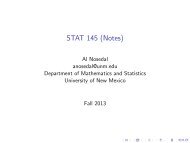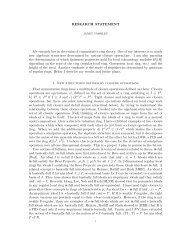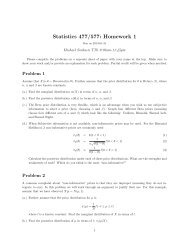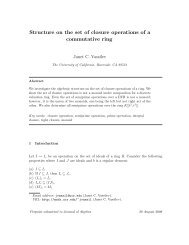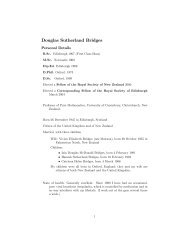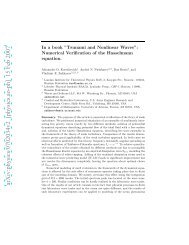OEO Office of Equal Opportunity - Department of Mathematics and ...
OEO Office of Equal Opportunity - Department of Mathematics and ...
OEO Office of Equal Opportunity - Department of Mathematics and ...
Create successful ePaper yourself
Turn your PDF publications into a flip-book with our unique Google optimized e-Paper software.
150 ARTS AND SCIENCES<br />
567./360. Human Behavioral Ecology. (3) Kaplan<br />
Introduces students to the fundamental principles <strong>of</strong> evolutionary<br />
theory <strong>and</strong> their application to human behavior. It<br />
surveys current research on human sexuality, mate choice,<br />
reproduction <strong>and</strong> parenting from the perspective <strong>of</strong> human<br />
evolutionary ecology. (B, HEE)<br />
568./365. Anthropology <strong>of</strong> Health. (3) Hurtado<br />
Analysis <strong>of</strong> systems <strong>of</strong> health, curing <strong>and</strong> disease in aboriginal,<br />
western <strong>and</strong> pluralistic societies. (B, HEE) {Offered<br />
periodically}<br />
570. Advanced Topics in Archaeology. (3 to a maximum<br />
<strong>of</strong> 15) ∆ (A)<br />
572./372. Analytic Methods in Anthropology. (4)<br />
Introduction to basic qualitative <strong>and</strong> quantitative analytic<br />
methods in anthropology. (A) {Fall}<br />
573. Advanced Technical Studies in Archaeology. (3) (A)<br />
573L./473L. Archaeological Measurement <strong>and</strong><br />
Laboratory Analysis. (4) Ramen<strong>of</strong>sky<br />
Emphasizes the methods <strong>and</strong> techniques employed to construct<br />
<strong>and</strong> analyze archaeological materials. Style, function<br />
<strong>and</strong> technology <strong>of</strong> flaked <strong>and</strong> ground stone <strong>and</strong> ceramics are<br />
considered. Course work includes readings, discussions <strong>and</strong><br />
laboratory exercises. Exercises focus on the construction,<br />
analysis <strong>and</strong> interpretation <strong>of</strong> data.<br />
Prerequisite: 320. (A) {Alternate years}<br />
574. History <strong>and</strong> Theory <strong>of</strong> Archaeology. (3)<br />
Ramen<strong>of</strong>sky<br />
Advanced review <strong>of</strong> development <strong>of</strong> prehistoric archaeology<br />
<strong>and</strong> Old <strong>and</strong> New Worlds until the 1960s, emphasizing<br />
culture history, social evolution, diffusion, culture areas, etc.<br />
(A) {Fall}<br />
575./375. Archaeology Field Session. [Summer<br />
Archaeology Field Session.] (2-6 to a maximum <strong>of</strong> 12) ∆<br />
Wills, Huckell, Ramen<strong>of</strong>sky<br />
Intensive instruction in archaeological field <strong>and</strong> laboratory<br />
techniques <strong>and</strong> the opportunity for independent student<br />
research.<br />
Restriction: permission <strong>of</strong> instructor. (A)<br />
576. Seminar: Southwestern Archaeology. (3) Wills,<br />
Crown<br />
In-depth analysis <strong>of</strong> current research issues <strong>and</strong> topics in<br />
Southwest archaeology. (A)<br />
577. Seminar: European Prehistory. (3) †† Straus<br />
Explores critical issues <strong>and</strong> debates in different periods <strong>of</strong><br />
European prehistory, based on primary sources. (A)<br />
579. Current Debates in Archaeology. (3)<br />
Advanced discussion <strong>of</strong> current theoretical debates in archaeology,<br />
including Processual <strong>and</strong> Post-processual paradigms,<br />
formation processes; middle-range, optimal foraging, evolutionary,<br />
hunter-gatherer mobility theories; cultural ecology;<br />
<strong>and</strong> origins <strong>of</strong> agriculture <strong>and</strong> complex society. (A)<br />
580./480. Ceramic Analysis. (3) Crown<br />
Basic concepts, methods <strong>and</strong> approaches used in the analysis<br />
<strong>of</strong> archaeological pottery. Lectures cover concepts <strong>and</strong><br />
strategies. Labs give practical experience with techniques<br />
<strong>of</strong> analysis. (A)<br />
581./381. Ethics in Anthropology: A Four Field<br />
Approach. (3)<br />
The class examines topical issues such as human rights,<br />
indigenous rights, researcher rights, <strong>and</strong> pr<strong>of</strong>essional <strong>and</strong><br />
scientific responsibility that face the various subfields <strong>of</strong><br />
anthropology in its everyday practice. {Spring}<br />
582./402. Museum Practices. (3) Szabo<br />
(Also <strong>of</strong>fered as MSST, ARTH 507.) History, philosophy <strong>and</strong><br />
purposes <strong>of</strong> museums. Techniques <strong>and</strong> problems <strong>of</strong> museum<br />
administration, education, collection, exhibition, conservation<br />
<strong>and</strong> public relations. {Offered upon dem<strong>and</strong>} (E)<br />
582L./482L. Geoarchaeology. (3) Smith, Huckell<br />
(Also <strong>of</strong>fered as EPS 582L.) Application <strong>of</strong> geological concepts<br />
to archaeological site formation with emphasis on<br />
pre-ceramic prehistory <strong>of</strong> the southwestern United States.<br />
Quaternary dating methods, paleoenvironment, l<strong>and</strong>scape<br />
evolution, depositional environments. Quaternary stratigraphy,<br />
soil genesis, sourcing <strong>of</strong> lithic materials, site formation<br />
processes. Required field trip.<br />
Prerequisites: (ANTH 121L <strong>and</strong> 220) or (EPS 101 <strong>and</strong> 105L).<br />
Restriction: at least junior st<strong>and</strong>ing. {Spring} (A)<br />
584./384. Peoples <strong>of</strong> Mexico. (3)<br />
Emergence <strong>of</strong> the modern Indian <strong>and</strong> Mestizo cultures <strong>of</strong><br />
Mexico <strong>and</strong> Guatemala. Persistence <strong>and</strong> change in social<br />
institutions <strong>and</strong> cultural patterns. (E) {Alternate years}<br />
585./485. [585.] Seminar in Museum Methods. (3 to a<br />
maximum <strong>of</strong> 6) ∆<br />
(Also <strong>of</strong>fered as MSST, ARTH 585.) Theoretical <strong>and</strong> practical<br />
work in specific museum problems.<br />
Prerequisite: 402 or ARTH 407. (E)<br />
586./486. [586.] Practicum: Museum Methods. (3 to a<br />
maximum <strong>of</strong> 6) ∆<br />
(Also <strong>of</strong>fered as MSST, ARTH 586.) Practicum in museum<br />
methods <strong>and</strong> management. (E)<br />
Prerequisite: 585 or ARTH 585. {Offered upon dem<strong>and</strong>}<br />
587./387. Peoples <strong>and</strong> Cultures <strong>of</strong> the Circum-<br />
Caribbean. (3)<br />
Outlines the sociocultural transformation <strong>of</strong> the region since<br />
1492. Emphasis upon cultural legacies <strong>of</strong>, <strong>and</strong> resistance<br />
to, colonialism, the Afro-Caribbean <strong>and</strong> Hispanic heritages<br />
<strong>and</strong> the contemporary trans-nationalization <strong>of</strong> isl<strong>and</strong> identities.<br />
(E)<br />
588./385. Images <strong>of</strong> the Indian in American Culture. (3)<br />
Analysis <strong>of</strong> literary, historical, ethnographic <strong>and</strong> contemporary<br />
texts, written by both Indians <strong>and</strong> non-Indians, to underst<strong>and</strong><br />
Native American peoples’ reaction <strong>and</strong> adjustment to conquest<br />
<strong>and</strong> domination. (E)<br />
Prerequisite: 331. {Offered periodically}<br />
590./390. Archaeology <strong>of</strong> the Southern Great Plains. (3)<br />
This course provides an introduction to the environment,<br />
physiography, <strong>and</strong> human cultures <strong>of</strong> the Southern Great<br />
Plains <strong>of</strong> Northern America from its earliest peopling to<br />
the time <strong>of</strong> European exploration <strong>of</strong> the region. {Alternate<br />
years}<br />
Prerequisite: 331.<br />
591./491. Population Genetics. (3)<br />
(Also <strong>of</strong>fered as BIOL 591.) This course investigates how<br />
genetic variation is patterned within <strong>and</strong> between <strong>and</strong> how<br />
these patterns change over time. Topics include neutral theory,<br />
population structure, phylogenetics, coalescent theory,<br />
molecular clock, <strong>and</strong> laboratory methods.<br />
597. Problems. (1-3 to a maximum <strong>of</strong> 6)<br />
Limited to graduate majors in the master’s program. (A, B,<br />
E, HEE)<br />
598. Advanced Research. (3, no limit) ∆<br />
Limited to graduate majors in the master’s program. (A, B,<br />
E, HEE)<br />
599. Master’s Thesis. (1-6)<br />
Offered on a CR/NC basis only. (A, B, E, HEE)<br />
651./451. Bioarchaeology. (3)<br />
The analysis <strong>of</strong> the skeletal remains from past human populations,<br />
oriented at the mortality, morbidity <strong>and</strong> genetic affinities<br />
<strong>of</strong> those extinct populations.<br />
Prerequisite: 351L. (B)<br />
656./456. Field School in Biological Anthropology. (3-6<br />
to a maximum <strong>of</strong> 12) ∆<br />
A course in the field <strong>and</strong> laboratory techniques used in<br />
Biological Anthropology. The focus varies by instructor to<br />
UNM CATALOG 2006–2007 Symbols, page 611.


